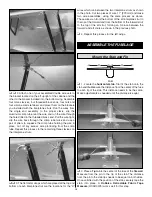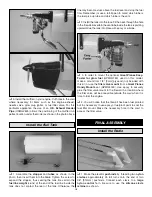
3. I will perform my initial turn after takeoff away from the pit
or spectator areas and I will not thereafter fly over pit or
spectator areas, unless beyond my control.
4. I will operate my model using only radio control
frequencies currently allowed by the Federal
Communications Commission...
During the last few moments of preparation your mind may
be elsewhere anticipating the excitement of the first flight.
Because of this, you may be more likely to overlook certain
checks and procedures that should be performed before the
model is flown. To help avoid this, a checklist is provided to
make sure these important areas are not overlooked. Many
are covered in the instruction manual, so where appropriate,
refer to the manual for complete instructions. Be sure to
check the items as off they are completed (that's why it's
called a
check list!).
❏
1. Fuelproof all areas exposed to fuel or exhaust residue
such as the cowl mounting blocks, wing saddle area, etc.
❏
2. Check the C.G. according to the measurements
provided in the manual.
❏
3. Be certain the battery and receiver are securely
mounted in the fuse. Simply stuffing them into place
with foam rubber is not sufficient.
❏
4. Extend your receiver antenna and make sure it has a
strain relief inside the fuselage to keep tension off the
solder joint inside the receiver.
❏
5. Balance your model laterally as explained in
the instructions.
❏
6. Use thread locking compound to secure critical
fasteners such as the set screws that hold the wheel
axles to the struts, screws that hold the carburetor arm
(if applicable), screw-lock pushrod connectors, etc.
❏
7. Add a drop of oil to the axles so the wheels will turn freely.
❏
8. Make sure all hinges are
securely
glued in place.
❏
9. Reinforce holes for wood screws with thin CA where
appropriate (servo mounting screws, cowl mounting
screws, etc.).
❏
10. Confirm that all controls operate in the correct direction
and the throws are set up according to the manual.
❏
11. Make sure there are silicone retainers on all the
clevises and that all servo arms are secured to the
servos with the screws included with your radio.
❏
12. Secure connections between servo wires and Y-
connectors or servo extensions and the connection
between your battery pack and the on/off switch with
vinyl tape, heat shrink tubing or special clips suitable
for that purpose.
❏
13. Make sure any servo extension cords you may have
used do not interfere with other systems (servo arms,
pushrods, etc.).
❏
14. Secure the pressure tap (if used) to the muffler with
high temp RTV silicone, thread locking compound or
J.B. Weld.
❏
15. Make sure the fuel lines are connected and are not
kinked.
❏
16. Use an incidence meter to check the wings for twists
and attempt to correct before flying.
❏
17. Balance your propeller (and spare propellers).
❏
18. Tighten the propeller nut and spinner.
❏
19. Place your name, address, AMA number and
telephone number on or inside your model.
❏
20. Cycle your receiver battery pack (if necessary) and
make sure it is fully charged.
❏
21. If you wish to photograph your model, do so before
your first flight.
❏
22. Range check your radio when you get to the flying
field. Perform the range check with the engine
running and without the engine running.
The Tiger Moth is a great-flying model that flies
smoothly and predictably. The Tiger Moth does not,
however, possess the self-recovery characteristics of a
primary R/C trainer and should be flown only by
experienced R/C pilots.
A fully cowled engine may run at a higher temperature than
an un-cowled engine. For this reason, the fuel mixture
should be richened so the engine runs at about 200 rpm
below peak speed. By running the engine slightly rich, you
will help prevent dead-stick landings caused by overheating.
CAUTION:
If, while flying, you notice any unusual sounds,
such as a low-pitched “buzz,” this may indicate control
surface
flutter. Because flutter can quickly destroy
components of your airplane, any time you detect flutter
you must
immediately
cut the throttle and land the
airplane! Check all servo grommets for deterioration (this
may indicate which surface fluttered) and make sure all
pushrod linkages are secure and free of play. If the control
surface fluttered once, it probably will flutter again under
similar circumstances unless you can eliminate the free-
play or flexing in the linkages. Here are some things which
can cause flutter: Excessive hinge gap; Not mounting
control horns solidly; Poor fit of clevis pin in horn; Side-
play of pushrod in guide tube caused by tight bends; Poor
fit of Z-bend in servo arm; Insufficient glue used when
gluing in the elevator joiner wire; Excessive
play or
backlash in servo gears; and Insecure servo mounting.
Fuel Mixture Adjustments
FLYING
CHECK LIST
24





































